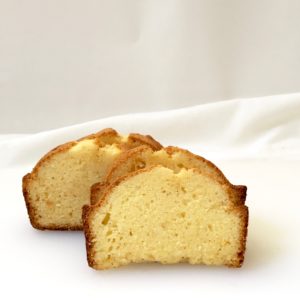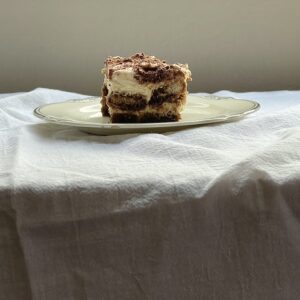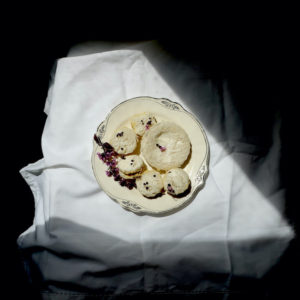Deviled Eggs: notes, technique, and a recipe

Chances are you can hardboil an egg. But tell me, how are you at peeling that egg? Until recently, hardboiled eggs Chez IK looked like they’d won first place at the local tractor pull.
Enter Gabrielle Hamilton, she of the dictatorial Prune Cookbook.
Spend any time with this highly idiosyncratic work and find yourself caught between admiration and utter frustration. Ostensibly written for new hires at Hamilton’s New York City restaurant, Prune’s recipes are set out “per order.” Sometimes these orders are whittled down to home kitchen portions; often they are not. Consider the Smokey Braised Beef Brisket–let’s not even discuss the french fries that go with. You’ll need the entire brisket, weighing in at 8 pounds. Want to make grilled ribeye steak? Grab yourself a “whole #109.” Butcher your 109 into 13 orders weighing between 14-16 ounces each. If you’re slick, and can carve 14 steaks out of your 109, even better.
Woe betide the home cook preferring–or needing–to cook in lesser quantities.

Nevertheless, should you be willing to ride the tide of Bourdanian insults and enormous portions, you’ll learn a lot. If the idea of downsizing restaurant yields annoys or intimidates, turn to “Prep Daily/Weekly” and “Garbage.” Consider Mixed Meat Stock with Walk-in Detritus, useful even if you don’t have a walk-in. Surely you have detritus; I certainly do. The Garbage section is true genius, putting to use scraps most of us would toss. Do you save smoked fish skins? Did you ever think of flinging them in a pan with soy sauce, scallion, mirin? I sure as hell didn’t until Hamilton told me to, and they’re amazing. So are zucchini tops, which for whatever dumb reason I thought inedible. It takes a Gabrielle Hamilton to re-think ingredients like that. Which is why people like me willingly fork over $45 for her book, whole 109 or no.
Then there’s Hamilton’s advice about neatly peeling hardboiled eggs.

The perfectly peeled egg may be summarized in two words: cold water. As the Talmudic scholars say, the rest is talk.

This recipe is a two parter: there’s the boiling/peeling/ultimate beautiful white process, and there’s the stuffing. None of this is difficult. Rather, it is a way of addressing the deviled egg that removes deviltry from preparation, leaving the flavor up to you.
Before launch, the excuses, or advice I did not follow.
Excuse number 1, concerning the piercing of eggshells: I did not pierce the eggshell with a pushpin, a step taken to prevent exploding eggs. Believe me, I tried. But my pushpins must be dull, or my eggs especially stubborn. The pins wouldn’t penetrate the shells. The eggs did not explode. They never do.
Excuse number 2, concerning ice cubes: Most people have refrigerators dispensing ice on command. Not for nothing is this blog titled “the Insufficient Kitchen.” In addition to all our other problems, the fridge lacks an ice maker. However, multiple varieties of tendonitis means multiple varieties of icepack in my freezer. Added to a bowl of water, they create instant ice baths.
This is a fine time to confess that while creating one ice bath, I grabbed an icepack from the freezer and found a missing wrist brace–the small wristband type–stuck to it. This icepack lives inside a fabric sleeve; evidently the wrist brace, which had gone AWOL the night before, had affixed itself while I’d iced down my tendonitic elbow.
Although Prune offers much advice concerning unannounced Health Department visits–for example, hiding serrano ham in the oven–Hamilton is oddly mute on the topic of frozen wrist braces.

Deviled Eggs
Adapted from Gabrielle Hamilton’s Prune, with gratitude for instruction on technique
yield: 16 eggs
prep time: approximately 30 minutes
8 large eggs
for the stuffing:
2 tablespoons Spectrum Organic Mayonnaise or Hellman’s/Best (depending on where your live and how sniffy you want to be about mayo)
2 teaspoons sharp mustard: I used Amora
1/8 teaspoon cayenne pepper or less, to taste
In the Prune cookbook, Gabrielle Hamilton advises piercing the tip of each egg with a pushpin to keep prevent exploding while boiling. I skipped this step, but go ahead if you wish.
Bring a large pot of water to a rolling boil. Using a large slotted spoon or Chinese kitchen spider, gently lower the eggs into the water. Once water returns to a rolling boil, count ten minutes.
While the eggs boil, prepare an ice bath.
Once the ten minutes are up, remove the eggs from the water to the ice bath. I find eggs easier handle with this brief cooling. Crackle the shells on a countertop, then return them to the ice bath. Allow eggs to sit in water about 10 minutes. The ice water stops the eggs from cooking and permeates the shells, making peeling easy.
Most cookbooks suggest peeling eggs under running water. As I live in drought-stricken California, I prefer peeling eggs in the ice bath itself, keeping eggs underwater as I remove the shells. They come away easily.
Have two bowls ready. Fill one with cool water.
Slice the peeled eggs in half. Using either a teaspoon or your very clean fingers, carefully slip yolks into the empty bowl. Place the whites in the bowl of cool water, where any clinging bits of yolk will come free.
Once all the yolks are removed, place whites in refrigerator while you make filling.
To make the filling, gently mash yolks with a potato masher or fork. Stir in the mayonnaise and mustard. Add a little cayenne, tasting as you go: you may want to add more, but there’s no going back on too much. Feel free to add more mayonnaise. I live a mayonnaise and sour cream hater, meaning this filling is quite mustard-forward. If he weren’t eating these, they’d be much, much creamier.
Once the filling is flavored to your liking, remove the whites from the fridge. Turn them upside down on paper towels or clean dish towels and allow them to dry.
You can stuff eggs using a pastry piping bag, should you have such a thing, or jury rig one by spooning filling into a plastic bag and cutting off the tip. Or you can take the lazy way out, as I do, and use a 1/2 teaspoon to scoop mixture into whites.
Eat within three days. Keep refrigerated.
Notes:
Filling variations are many: add a little crème fraîche. Squeeze lemon juice over all. Sliver preserved lemon peel into the filling. Use sweet or spicy pimenton instead of cayenne. Real mayonnaise is always a good thing. Olive oil or butter can replace the mayo.
The water you boiled your eggs in is perfectly useful for other cooking–boiling potatoes, chard, or artichokes, for example. Or allow it to cool and use it to wash dishes.
Filling can be made in food processor, or a mini-processor, though these amounts are so small that it’s hardly worth the washing up.





